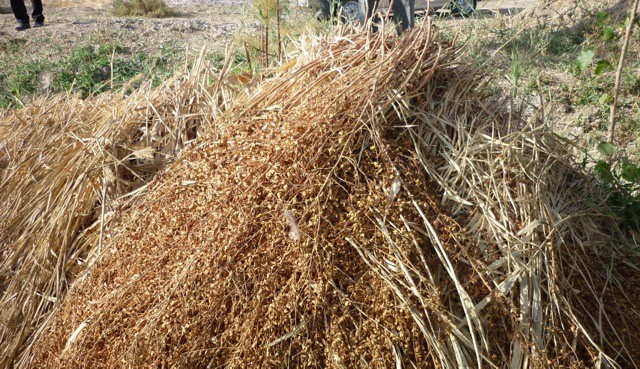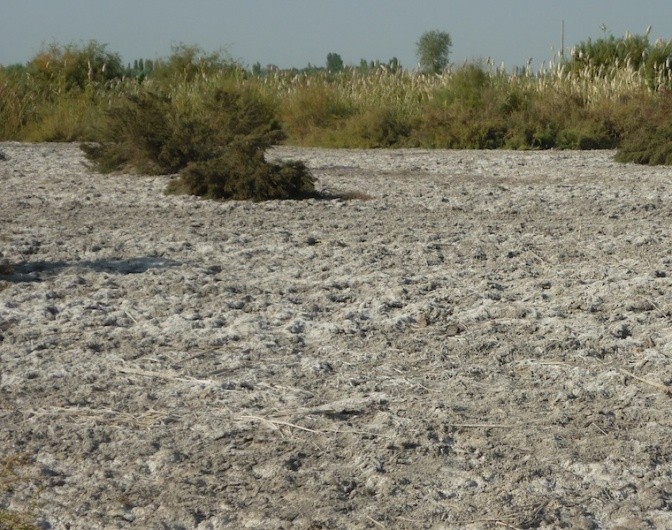This blog is part of the Agriculture and Ecosystems Blog’s month-long series on Restoring Landscapes. Andrew Noble, Director of the CGIAR Research Program on Water Land and Ecosystems, will be participating in Global Soil Week October 27-31, 2013.
In the harsh climate of northwestern Uzbekistan, farmers are cultivating wild licorice on land that is salt-ridden near drainage canals.
The tops of the shrubs, established either from roots or seed, are cut for livestock fodder and, by the third year, some farmers dig up the roots to export for profit to Japan, South Korea, and the Ukraine. Extract from licorice roots is used worldwide in medicines, candy, food, alcohol and even cosmetics.
 Dried licorice tops are fed to livestock in the winter. Photo: Andrew Noble/IWMI
Dried licorice tops are fed to livestock in the winter. Photo: Andrew Noble/IWMIToday, the CGIAR Research Program on Water, Land and Ecosystems (WLE) also is eyeing licorice as a potential low-cost option to rehabilitate soil stripped of its fertility because of high salinity. Farmers in the region already have abandoned an estimated 30,000 hectares of land degraded by over-irrigation in the Aral Sea Basin to support a cotton and wheat economy dating back to the Soviet era. Licorice is a salt-tolerant plant that not only thrives in such tough conditions but helps regenerate the soil.
“The key is the deep-rooted nature of licorice and its ability to drop the water table, thereby preventing salt from rising to the surface of the soil,” says Andrew Noble, Director of the CGIAR Research Program on Water, Land and Ecosystems and a soil scientist by background. In effect, salt collected in the soil is gradually flushed out, enabling the land to be irrigated again for wheat and cotton.
Noble was involved in a similar project less than a decade ago in southern Uzbekistan but, despite promising results, funding stopped after four years. Interest re-kindled during a breakfast conversation last April between Noble and Karen Brooks, Director of the Policies, Institutions and Markets (PIM) CGIAR Research Program, at a conference in Dublin.
“Licorice is endemic to the region,” Noble says. “When you speak to farmers, they say, ‘I knew it (licorice) growing up.’”
Assessing the global markets for licorice
PIM, led by the International Food and Policy Research Institute, and WLE are funding a project to map licorice production in the Nukus district of northern Uzbekistan, assess other potential sites, and examine the market potential within the global context. The research will assist the government of Uzbekistan in a range of land rehabilitation initiatives planned and financed by the World Bank and Global Environmental Facility for the region.
“We think these are just cottage industries (today),” Noble says. “That’s why it’s important (for PIM) to look at these markets” before promoting the industry.
“This is a very exciting initiative, and it shows the pay-off to partnership,” Brooks says. “Neither WLE nor PIM could do this as well separately as we can do it working together. And we need the implementation partners, as well — the farmers, local research institutes, and financing partners.”
Several farmers are interested in establishing licorice on salinized land and WLE is planning to monitor water tables and salinity on a 100-hectare site that will be established by one of these farmers.
Irrigated farmland affected by high salinity
 Salt affected land to be established to licorice. Photo: Andrew Noble/IWMI
Salt affected land to be established to licorice. Photo: Andrew Noble/IWMI
Worldwide, an estimated 34 million hectares of irrigated farmland are affected by high salinity, representing 11 percent of the total irrigated land, according to the U.N. Food and Agriculture Organization. If these lands were rehabilitated, they could effectively produce 20 percent of the global wheat production, Noble estimates, which could generate an additional $42 billion of revenue a year.
“When you look at the problem (of high salinity), it’s massive across Central Asia,” Noble says. “The options farmers have are either to abandon their land or invest heavily” in expensive drainage systems.
While licorice could be a low-cost land rehabilitation option in Central Asia, other salt-tolerant varieties of sorghum, millet and alfalfa might be appropriate in some of these ecological zones, Noble says.
Licorice production in Northern Uzbekistan
In a field trip to Nukus earlier this month, Noble found wild licorice fields being cultivated in three-meter-wide strips along the banks of drainage canals.
Scientists with the Tashkent Institute of Irrigation and Amelioration told Noble that the most significant issues facing the region are high-saline water and reduced flows from the Aral Sea. Because the land is flat and water tables have been elevated by intensive cotton and wheat farming, water moves slowly, allowing salt to collect in the soil.
Noble says he saw evidence salt had accumulated on the surface of the soils in the area. Farmers commented that not only did licorice shrubs thrive, but the higher the salt content of the soil, the higher the quality of the roots. Licorice roots contain a natural sweetener called glycyrrhizin.
Some farmers are using the plants for livestock fodder only, while others have been exporting the roots for the past three years.
One farmer indicated he made between $250 and $300 per ton of dry root, accounting for 80 percent of his farming profits. He was able to get government approval to grow licorice on a 100-hectare plot considered outside the government cotton and wheat plan.
Challenges to overcome
“An interesting aspect that came out of discussions with these farmers is they make no money from their production of wheat” and often scramble to break even or make a small profit from cotton, Noble says.
Challenges must be overcome to cultivating licorice for profit and land rehabilitation.
Farmers may have to get permission from the government to grow the licorice in the abandoned areas, since irrigated farmland is designated for cotton and wheat.
As the licorice crop grows out, roots spread and dominate an area. Herbicides may be necessary to manage the “weediness” of the crop, Noble says.
The seeds are extremely small and farmers reported they are only able to get about 20 percent of the seeds established into plants – they asked for and might need assistance to more efficiently cultivate their crop through seeding or root cuttings.
Farmers also said they harvest roots manually and that production increases would be contingent on mechanizing the process.
Evidence in favor of licorice is mounting
This isn’t the first time researchers have examined licorice’s potential to rehabilitate degraded lands.
Between 2005-2008, researchers from the International Water Management Institute (IWMI) examined licorice in southern Uzbekistan in a project funded by the Asian Development Bank.
Researchers tested two small plots at Gulistan State University in Syr Darya province – one a control plot and the other cultivated with licorice. They demonstrated that the salt content in the licorice plot declined enough to return to a cotton/wheat crop rotation after four years.
IWMI recommended that the government release abandoned lands for 15 years to enable farmers to make some money before turning the land back over to cotton and wheat production.
But further support for the project wasn’t forthcoming. Now comes another opportunity.
“This could be a flagship investment model,” Noble says. “We’re not talking about expanding (farmland). It’s there. The beauty of this is that you’re taking land that’s been abandoned and making it productive once again.”

















Comments
We faced a similar catastrophe in North Cyprus at the end of 1980s where coastal aquifers were being intruded by saline sea-water due to excessive pumping of the groundwater reserves; this caused damage to surrounding orange orchards. We employed 'recharge wells' after similar examples to Israeli misfortunes dealt mainly by Prof. Jacob Bear.
I was asked by Michael Victor to post my reply on Linkedin here so you could see my comments.
Interesting article, but it let me with lots of questions. First irrigated crops are annuals that are planted every year, which also means more plowing, tilling, soil manipulation, fertilization, etc. Since cultural practices and uses for licorice are totally different than grain crops or fiber crops, how are you comparing the total difference just due to licorice. You would also have to incorporate another perennial crop that would be in the ground for the same amount of time in order to see if the exudates from the licorice root are the difference or if taking the soil out of annual production for three to four years is the factor.
If licorice is native to the area, then the difference could also be due to soil microbes that have built symbiotic relationships with this native plant. I am suspicious that the grain and fiber crops presently grown are not native.
The reference to the crops being brought in during Soviet occupation also makes me wonder. The Soviets were known to exploit the resources of the non-Russian countries and use them up while preserving Russian resources. To continue use of the land in the same way is still exploitive and it sounds like no efforts to restore fertility and sustainability of the soil has been addressed until now. I know that many soils in Uzbekistan are considered marginal too, so the present methods could be turning land that traditionally was used for pasture into desert. There is usually not one magic bullet that will restore soils to their original state. Restoring the water table, restricting fertility to the level the soil can actually handle, getting more organic matter back into the soil (if possible), etc. are all needed. One plant that has shown promise by the stream banks, and incidentally not grown in the middle of the production area, seems to me to be a reach. Also, do the farmers use the same level of other chemicals like herbicides, pesticides, fungicides (which also are usually in a salt form) on licorice? My guess is probably not. The research must be absolutely correct in its design to get the answer you want.